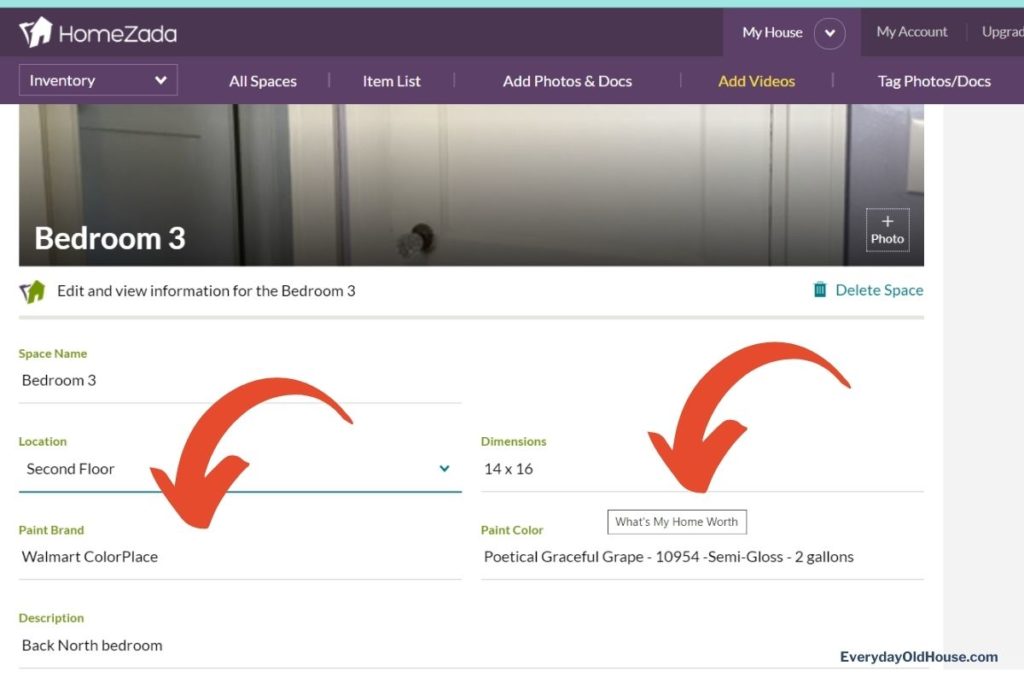Last Updated on December 17, 2023
Need new touch-up paint for your living room but can’t remember the original colors? Wracking your brain remembering that it was named after a food. Was it Gentle Cream? Or, wait, maybe is was Steamed Milk? (BTW, those are actual Sherwin Williams paint color names…). Did I buy satin or semi-gloss sheen? Hmm…. Remove second-guessing and get organized for good using these 6 simple and FREE ways to keep track of house paint colors.

This post contains affiliate links, including but not limited to, Amazon Associates. As such, I earn from qualifying purchases. Full disclosure located here.
Backstory
Our 5-year old twins are outgrowing their toddler beds in our smallest bedroom. It’s time to graduate to “big girl beds” and a larger bedroom.
And that means sprucing up the rooms with touch-up paint as we move furniture and change up décor.
Fortunately we still have most of the original paint cans are stored in our basement. Unfortunately, whenever we do touch-ups we run into two common problems:
- The paint has completely dried up (I’m not very good at completely closing up the lid on the can), and
- I’m a self-proclaimed messy painter so the label with essential information usually has been painted over.
Whoops.

And of course I can’t remember all the paint information – color hue, sheen, etc.. – needed to re-paint the room. And how can I? There are so different paint manufacturers, colors, and finishes. Plus there’s more than just the wall. There’s also the trim, base molding, closets, etc that are painted.
It’s so easy to lose track. And that got me thinking about different ways people can keep track of house paint colors.
What Information Should You Track?
When tracking house paint, there is SO much more than just the color name. Here’s 7 things to document when keeping track of house paint colors.
1. Room
Maybe you painted Steamed Milk in your dining room, but used Gentle Cream is in your living room. And now 5 years later you can’t remember which room you painted which beige color (and honestly, I’d be impressed if you did…). Start off tracking your house paint colors by writing down which room you used them in.
2. Location
Your individual rooms probably don’t have just one paint. You likely have different paints for walls, doors, trim, and ceiling. Plus, you may have used different paint for an accent wall, or closet, or even the fireplace. It’s important to document ALL the different types of paint in each room.
3. Manufacturer
Which brand did you use? Sherwin Williams? Valspar? Walmart? Personally, we have a conglomeration of manufacturers in our basement. I haven’t quite found my favorite manufacturer yet.
4. Finish
Flat, Eggshell, Semi-Gloss or Gloss? Color isn’t the only thing to consider when painting a room. It’s also important to understand which finish or sheen works best in your space.
The slightest difference in sheens can make your touch-up stand out. Buy Steamed Milk touch-up paint in semi-gloss when your original paint sheen was eggshell and you’ll end up with some weird shiny spots on your walls… (I speak from experience…)
5. Color Hue & Code
After spending weeks agonizing over the perfect paint color, which color hue did you choose? B sure to include both the color name and manufacturer formula number. Why? You can’t assume that in a few years the paint manufacturer may change color names. But the formula number might help you still get the right color.
And you can use your paint tracker to also take note of stained (aka unpainted) areas as well! If you know the stain color and sealant, be sure to take note of that as well!
6. Quantity
I’m horrible at figuring out how much paint I need to completely re-do a room. Save yourself some time and money when you first paint a room by documenting how many gallons or quarts used.
There is nothing worse than getting into a painting project and realizing you have to drop the paint brush and run to the hardware store to buy more. Or actually, even worse, realizing this at 9pm and the store is closed…
7. Sample
This one is optional, but in some of the 6 methods to keep track of house paint colors below, there is the option to add a paint chip. This is just another way to document your color.
6 Ways to Keep Track of House Paint Colors
Avoid the frustration when you need paint and you can’t remember the details. There is no more hunting and stressing with these 6 ways to keep track of house paint colors.
These ways are super easy to track your house colors AND free!
1. Back of Light Switch Cover Plate
A simple way to keep track of paint colors is to use the back of an electric light switch cover plate. Write the information on a piece of masking tape or painter’s tape and stick to the back of the electric outlet place. Personally I think this is a genius trick.
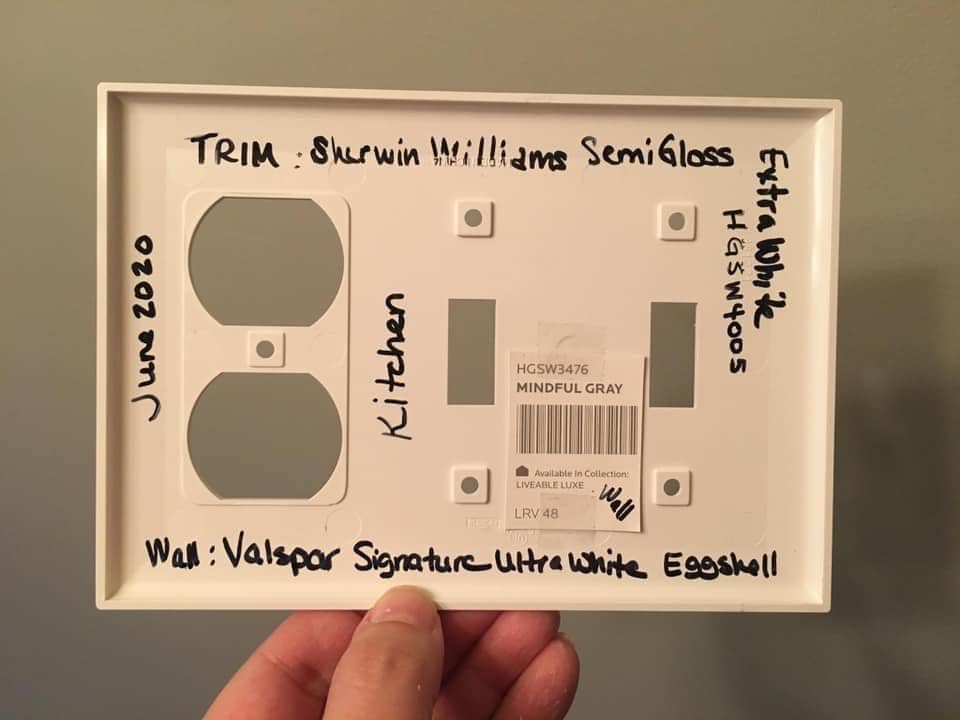
2. Planner Printout
If you’re a paper/binder kind of organizer, add a section in your homeowner journal to keep track of your paint colors. There’s a few free printables floating around on the internet, but my favorite one is from Betsy at Happily Every After Etc. She has a free Paint Planner Printout that is INCREDIBLY comprehensive. And honestly, it’s a beautiful design – quite colorful and eye-catching.
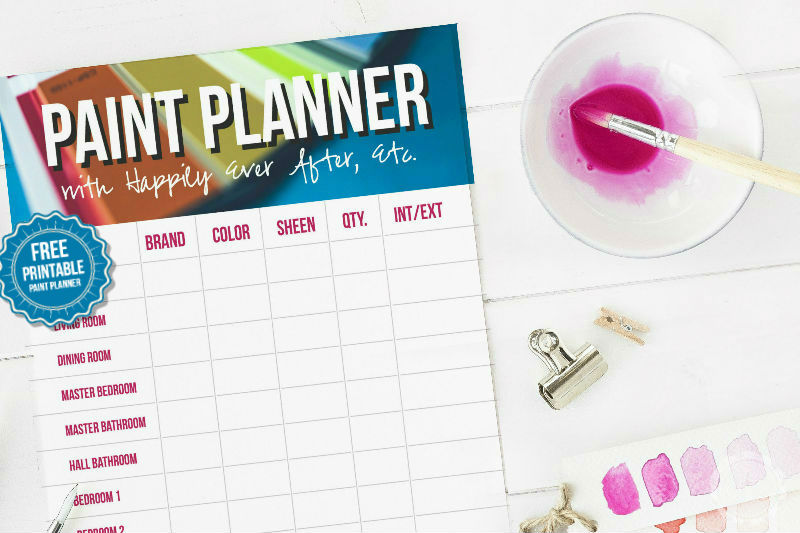
Quite simply, print out, complete with all your paint color information and add to your homeowner journal.
3. Google Docs
If you are more of an electronic/ paper-less person, instead of printables there’s always the option of a Google Sheets or Microsoft Excel spreadsheets. Personally, I’m a huge fan of Excel. But that requires printing the spreadsheet out before heading to the hardware store. So perhaps Google Sheets is better in this case since it’s online and can be pulled up anytime when visiting the hardware store.
I couldn’t find a fellow blogger with a shareable Google Sheet, so I created my own to share with you. It’s not fancy, but it works!
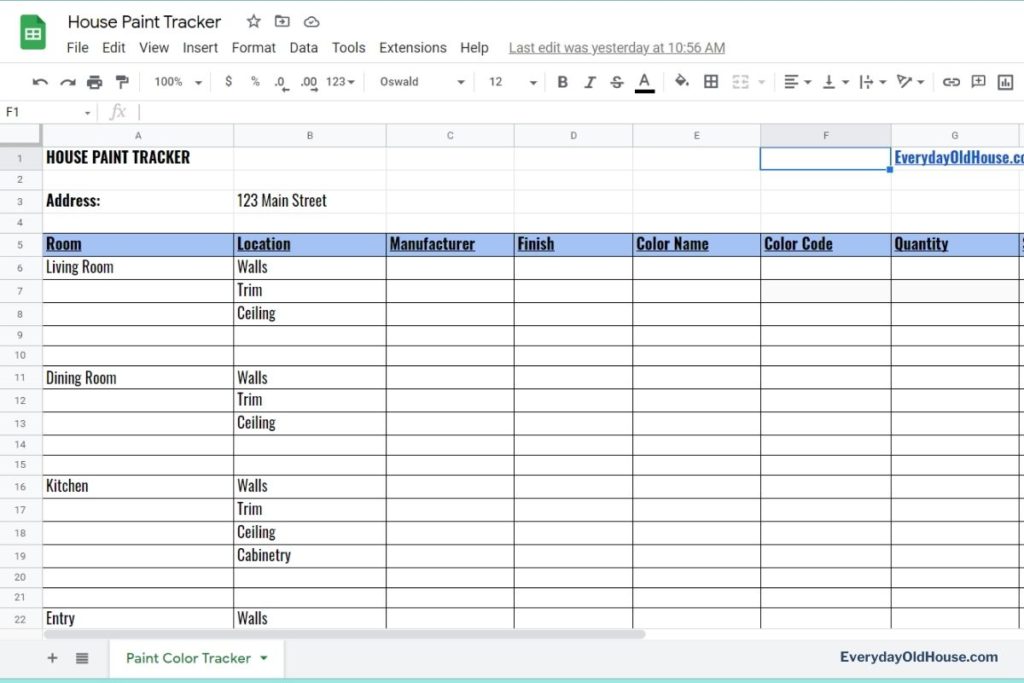
DOWNLOAD GOOGLE PAINT TRACKER TEMPLATE HERE
Directions: Create your own copy with these directions:
Click link > Go to File > Make a Copy > Click OK.
Now you have your very own copy to edit.
I’ve set up the basics. For example across the spreadsheet in the columns I’ve listed the 7 things to document about your house paint. And running down the first column I’ve listed basic rooms with “wall, trim and ceiling” paint.
But you can add and delete rows and columns. Modify to suit your needs!
If you prefer an Excel version, there is an option under File > Download > Microsoft Excel
Having problems? Please email me over at everydayoldhouse at gmail. I’m a one-woman show so it may take me a day or two to email. But I’ll get to you, I promise!
4. Home App
If you rely on a home app for your home management, it likely conatins a section for keeping track of house paint colors. Personally, I use (and recommend) HomeZada. Originally I signed up for HomeZada to create our free home inventory a few years ago when I dove into learning about emergency prep for our home.
But I’ve since learned that HomeZada (even the free version) is so more than just a home inventory program.
For example, in HomeZada software program each room or “space” has a section for homeowners to elaborate and provide details. These inputs allow users to document details like space dimensions, description, and… drum roll please…..paint brand and paint color!
5. Color Chips
When you originally decided on paint color for your home, you probably collected a bunch of paper paint color chips. Instead of recycling them, use them to keep track of your house paints.
Most of the information you need is right on the back – manufacturer, color name and identification number. Simply paste the paint chips into your homeowner journal and add the remainder of the information.

Another similar idea is to request the paint store print out an extra paint label that goes on the top of the can.
6. Paint Stirrers
This last one is perfect for hands-on DIYers to keep track of house paint colors, courtesy of Helena from A Personal Organizer.
Start by dipping the end of a paint stirrer into the can of paint. Once dry, write the paint information on the other end of the stirrer with a permanent marker.
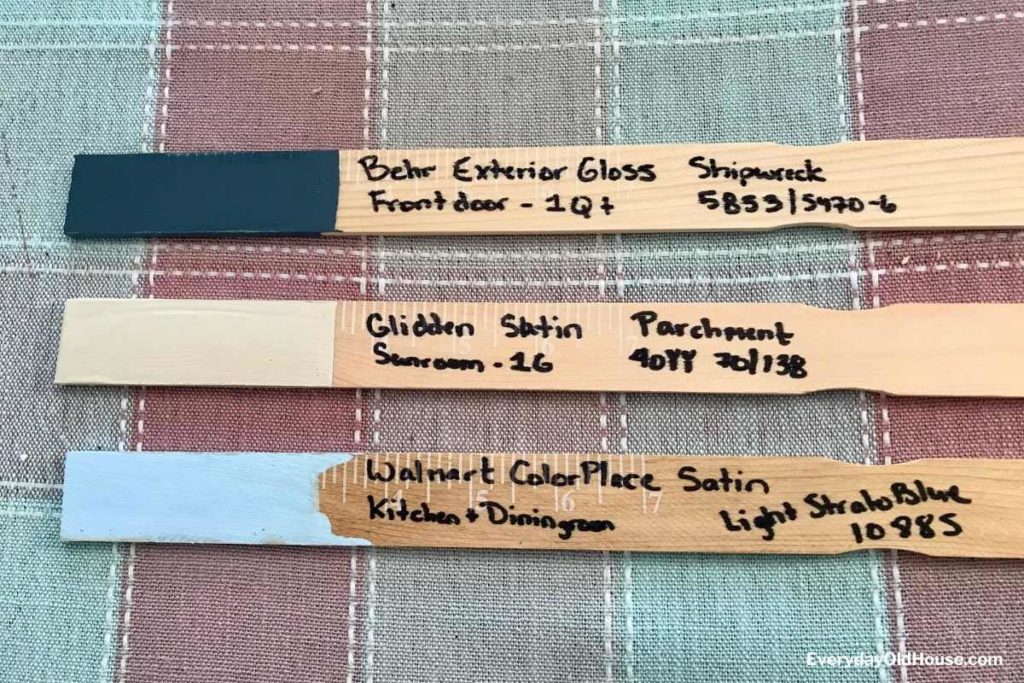
To keep the organizers organized, tie them together with twine or strong thread. Store them safely either near the paint cans themselves or with other household information, like a User Guides storage box.
Tips for Keeping Track of House Paint Colors
Lastly, I will leave you with a few general tips to keep track of house paint colors. I hope you find these useful!
- Rely on a professional painter? Give them a copy of your paint tracker to keep everything straight.
- Selling your house? Include a copy when you list your home on the market. If you were a potential homeowner, how happy would you be to know a home’s paint colors!
- Like the paint tracker printable? Now only put in your homeowner journal, but also tape a copy next to your paint cans.
Related Posts
Want to be the first to know about new posts? Be sure to follow me on Pinterest, Facebook, Instagram or Twitter of even Etsy! Or better yet… Subscribe below!
My monthly (admittedly sometimes more, sometimes less….) emails are like receiving a unexpected letter from an old friend WITHOUT needing to put on your slippers and walk out to your mailbox…. See? I got ya, my friend!)
[Note: My posts are proudly connected to these amazing link parties full of DIY ideas and inspiration!]
